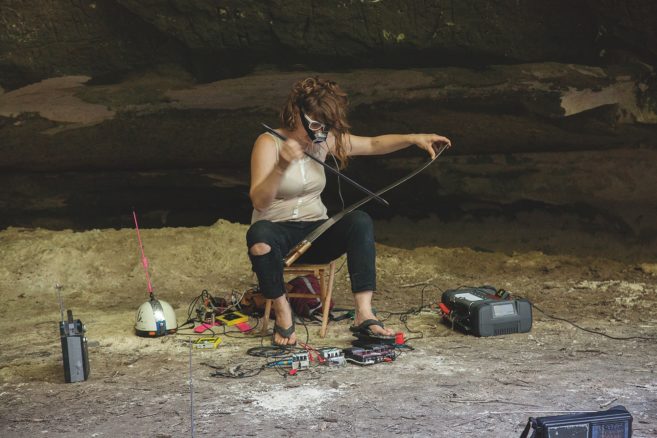When news broke this spring that Nova Scotia artist Steve Higgins was being audited by the Canada Revenue Agency (CRA), I received an email from Ingrid Jenkner, director of Mount Saint Vincent University Art Gallery in Halifax, about the artist’s troubles. “Steve exhibited a site-sensitive work at the MSVU Art Gallery in 2013—a sensational installation that was dismantled and donated at the end of the exhibition. The artist received grants to build the work on site and later received the [Nova Scotia] Masterworks Arts Award in recognition of his achievement.” In a 2018 audit, however, the CRA disallowed an expense claim related to Higgins’s work because it was not sold for profit—and for this reason the CRA labelled him a “hobby artist,” not a professional artist. The cost of this auditor’s distinction between pleasure and profession was clear and concrete: a bill totalling $14,495.37 in back taxes for Higgins.
Higgins is not alone. Several other artists reported their run-ins with CRA auditors to me but did not want to make them public for this story. Since Higgins’s ordeal came to light, the Canadian Arts Coalition (CAC), Canada Council for the Arts and the CRA have been working toward a resolution that, according to one CAC representative, “will hopefully be an updated, fully-accessible tax folio which results in clearer guidelines to help artists prepare their taxes accurately and for CRA agents to assess appropriately.” They say it will be “align[ed] with the realities of professional artists working primarily in the not-for-profit sector”—that is, a sector in which even artists who are considered professional and high-achieving may not sell much of their work.
But when this new tax folio comes out, will it respect the existing understanding, or will it necessitate another landmark case to test it? Several philosophical questions continue to face us: Who is considered a professional artist? How do we define artistic work? What does an artist do? There is also a more pragmatic query: How much does being an artist truly cost? “If the only [real] artists are the artists who make a ‘profit,’ then the Canadian art world just got a lot smaller,” says Glenn Alteen of Grunt Gallery in Vancouver. “Or, at least the professional art world gets smaller, while the amateur art world expands considerably. What can you say to this?”
In this recent debate, I hear echoes of an event from the early 1980s—the case of Toni Onley. In 1983, Onley challenged the rule that Revenue Canada would only allow him to give away his art up to a value of 20 percent of his income. So, according to the Vancouver Sun, “rather than pay tax on his [inventory], he said he would burn 1,058 prints—about half his stock of seascapes and landscapes. Each one had a retail value of $400 to $1,500.” The case got national media attention. “I’m making myself a test case,” Onley said. “This tax law was never intended for artists. There is no tax law that applies to artists, so they lump them with manufacturers. This is ludicrous.” Onley’s gambit worked: Canadian artists no longer have to pay taxes on their unsold inventory, but can still log costs associated with that inventory toward deductions, if needed.
In 2014, American painter and printmaker Susan Crile had a similar battle with the Internal Revenue Service in the US, one which she ultimately won in tax court. She spoke out: “I think this was an attempt to get rid of a whole category of people from being able to take tax deductions,” she said. “I’ve done a lot of political work that is not so easy, and it’s not easy to show or to sell. But I’m an artist. And if I’m not considered one, then I don’t know who could be.”
Vancouver artist Sandra Semchuk, whose Canada Council grant was flagged as undeclared income and was subsequently audited in 2010, is gravely concerned about the greater implications for economic survival of artists in Canada. “I was of the generation that worked to bring about nonprofit artist-run galleries,” says Semchuk. “Little did we know how deeply that system would make artists dependent on government awards and subsidies. For those of us whose practices are based on unravelling historical understories and injustices, the artist-run centres made it possible to exhibit our work and create national dialogue around significant issues…but exhibitions did not assure financial security.” The situation worsens if those grants are not regarded as professional income.
But fixing the tax situation is only part of the problem. The CRA’s existing rules, when interpreted properly, should never have classified Steve Higgins as a hobby artist in the first place. The CRA’s bulletin IT-504R2 lists factors used to determine if an artist has achieved professional status, which include “the amount of time devoted to artistic or literary endeavours,” “the extent to which an artist or writer has presented his or her own works in public and private settings,” and the artist’s “qualifications as an artist or writer, respectively, as evidenced by education and also by public and peer recognition received in the form of honours, awards, prizes and/or critical appraisal.” Higgins meets these criteria, but the CRA auditors did not consider public funding an eligible income source from which expenses could be deducted, and thus demonstrated a misunderstanding of how contemporary artists in Canada work. “It is one of the CRA’s favourite tricks to call artists hobbyists,” says Vancouver artist, editor and arts administrator Cornelia Wyngaarden, “but that can be swiftly dealt with by appealing to an authority or peer with recognition to submit a letter to the auditor stating that the artist is recognized as such by the community of artists. I was asked to intervene in one such case, with an artist who even had an MFA. I simply asked the director of a university gallery to write a letter of accreditation [and] the auditor backed off immediately…it was smooth sailing after that.”
As the ironies of these cases reveal, despite legislation, the status of artists in Canada is far from certain. UNESCO recently launched a survey on measures being taken to support the rights of artists, calling upon governments to “improve professional, social and economic status through the implementation of policies related to training, social security, employment, income and tax conditions, mobility and freedom of expression.” In 1980 Canada became a signatory to the UNESCO Recommendation Concerning the Status of the Artist and in 1992 it passed the federal Status of the Artist Act, although its provisions governing labour relations between federal arts organizations and self-employed artists did not come into effect until 1995. As legislation, it determines that artists should be fairly compensated for their work, and should have access to the same benefits as other labourers. But, since most cultural work in Canada falls under the jurisdiction of provincial labour laws, the federal Status of the Artist Act, while important for lobbying efforts, has been of little practical use for artists concerned with their personal finances.
This should not deter us. The effects of recognizing the socio-economic realities of practicing artists in Canada could be huge for policy development. Artists’ low income and status—in other words, their option to be categorized as “hobby artists” when only profit and income are regarded as key metrics—are international issues. Dutch artist, sociologist and cultural economist Hans Abbing has written extensively on why and how poverty in the arts is structural. “More money flowing into the arts only increases the number of poor artists,” writes Abbing. “However, an important difference exists between an increased demand for art (a shift in the demand curve) and a rise in support, whether through subsidies, grants, social benefits, donations or family support. All lead to more artists being poor, but only a rise in demand leads to a substantial increase in output in the sense that more art finds its way to consumers.”
The world of labour now looks a lot like the way art labour has looked for decades.
In 2018, the situation of artists is set against what is colloquially spoken of as the “gig-ification” of work—an evolution of the 1980s “flexibility of labour” tropes that saw the end of the social contract between employer and employee. In recent studies, Nicole Cohen and Greig de Peuter, members of the research group Cultural Workers Organize, argue that the fundamental idea of work and labour has radically changed. The world of labour now looks a lot like the way art labour has looked for decades, in this age of, to use Cohen and de Peuter’s wording, “deepening precarity, creative class boosterism, and do-what-you-love ideology.” But the notion of “art labour” being completely separate from other forms of labour is false. Toronto publisher and curator Michael Maranda points out: “The issues [for] surviving as an artist have become harder over the last 30 years, and that’s because the overall economy has shifted so that there aren’t as many lucrative day jobs available to support an art career—a career where median net income is around the break-even point.”
Contemporary labour—think of co-working spaces and flex time—plays into tropes that prioritize the needs of the owners, making the future of workers’ lives precarious. Where does this leave the question of what constitutes an artist’s professional practice? If the CRA does make a useful resolution on professional artist policy, will it still be relevant two years from now? Or even two months from now, in the fast-changing world of flexible, freelance work? “The art world exists on the edge of capitalism, as a gift economy that has a hard time keeping up in the digital age of crowd-funding,” observes Glenn Alteen. “Generational shifts are more prevalent than ever in an art market that can only overvalue or undervalue artwork and mirrors the wider economy with its part-time and contractual arrangements.” He continues: “The arts, in some ways, fly in the face of the economy because they work on a shared value system that is not really capitalism, and definitely not the liberal capitalism that is currently in play. It is, of course, back to the gift economy the arts have always employed but which gets less and less reception than it has in previous generations.”
 Steve Higgins, Beyond the Terminating
Vista (Rebuild) (detail), 2013. Building
lumber, dimensions variable. Courtesy MSVU Art Gallery. Photo: Steve Farmer.
Steve Higgins, Beyond the Terminating
Vista (Rebuild) (detail), 2013. Building
lumber, dimensions variable. Courtesy MSVU Art Gallery. Photo: Steve Farmer.
Many artists in Canada have fought for their rights through collective bargaining, even while unions have been disappearing in other workplaces. Long-time labour organizers and artist-activists Carole Condé and Karl Beveridge note that “we may have moved beyond the clichés of the starving artist, that you make art for the love of it, and that you exhibit for ‘exposure’ and not ‘reward,’ [but] artists are still vulnerable and underpaid. Society proclaims the importance and value of art, [but] still resists efforts…that would give artists the ability to negotiate better terms for their work. Artists have to understand that nobody gives you anything unless you collectively demand it.”
What people think constitutes “real” art and what “real” success in the art world looks like is often painful—and ultimately costs artists, both financially and otherwise. “People tend to attribute high and admirable qualities to art,” writes Abbing. “It is unpleasant to acknowledge that art has two faces and that it is profitable for artists to deny the economy. It is annoying to learn that monetary and aesthetic values coincide. It is hurtful to learn that donors and artists are not selfless. And it is disappointing to discover that the arts are not open and independent and that there is no such thing as an equal chance. …The picture remains disappointing because it contradicts the myths that surround the arts.”
In the decade since Lehman Brothers collapsed, and Damien Hirst earned a reported $198 million by staging his own auction at Sotheby’s, North American and European societies have undergone radical transformations; these events demonstrate a decisive shift in the art market. But should art be valued for its market value or its conceptual value—this is a question still being grappled with, at every level. As artist and writer Chris Wiley recently argued, “the figure of the artist-professional has been displaced by that of the artist-debtor. Under the sign of debt, the future must meet the needs of a series of predictable, regularized payments; this reality thus favours art that is predictable, regularized and produced in series.” Are we going to see a radically different art ecosystem in the near future, where the constraints of labour redefine the very purpose and meaning of art in our society? What would help artists in Canada, according to Steve Higgins, is for “the Canada Council to sit down with the CRA and have a serious conversation about what one arm of the government is doing to support Canadian culture and what another arm of government is doing to destroy it.”

 Ken Nicol, $10,000 promise (detail), 2014–17. Collected cheques, ink on paper and bottle, dimensions variable. Courtesy the artist/Olga Korper Gallery.
Ken Nicol, $10,000 promise (detail), 2014–17. Collected cheques, ink on paper and bottle, dimensions variable. Courtesy the artist/Olga Korper Gallery.







